Adult Education and Training: Learning Session Evaluation Report
VerifiedAdded on 2020/03/04
|7
|1368
|135
Report
AI Summary
This report provides an evaluation of adult education and training sessions, fulfilling the requirements of Unit Standard 20469. It details the implementation and analysis of three learning session evaluations, including descriptions of how the aims and methods of evaluation tools were explained to participants (using two tools per session). The report offers evidence of how the chosen tools obtained constructive feedback, aligning with organizational needs. It further analyzes the evaluation results, proposing delivery refinements based on expected outcomes. The report incorporates research beyond the provided readings, adheres to APA referencing, and follows the specified style guide, offering a thorough assessment of the training programs.
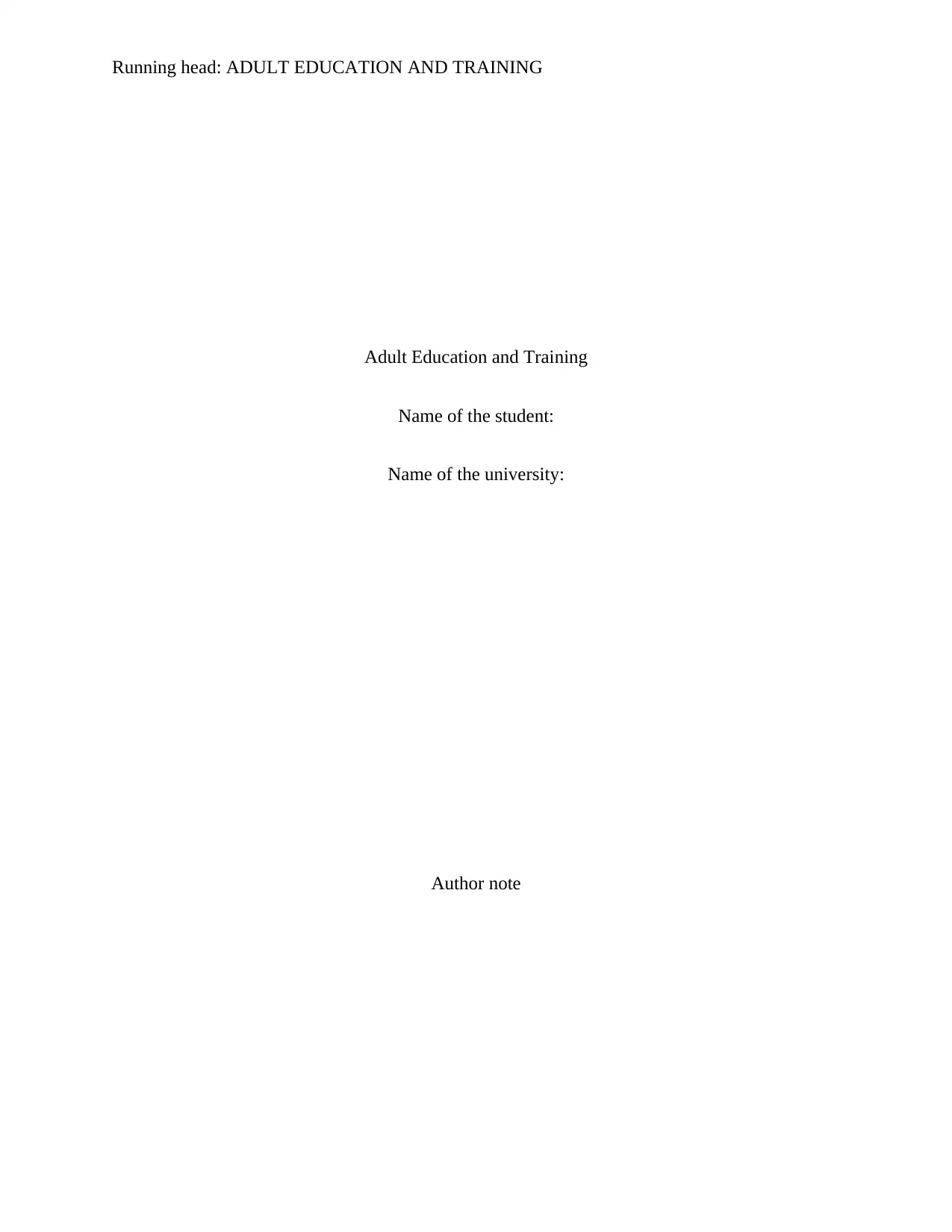
Running head: ADULT EDUCATION AND TRAINING
Adult Education and Training
Name of the student:
Name of the university:
Author note
Adult Education and Training
Name of the student:
Name of the university:
Author note
Paraphrase This Document
Need a fresh take? Get an instant paraphrase of this document with our AI Paraphraser
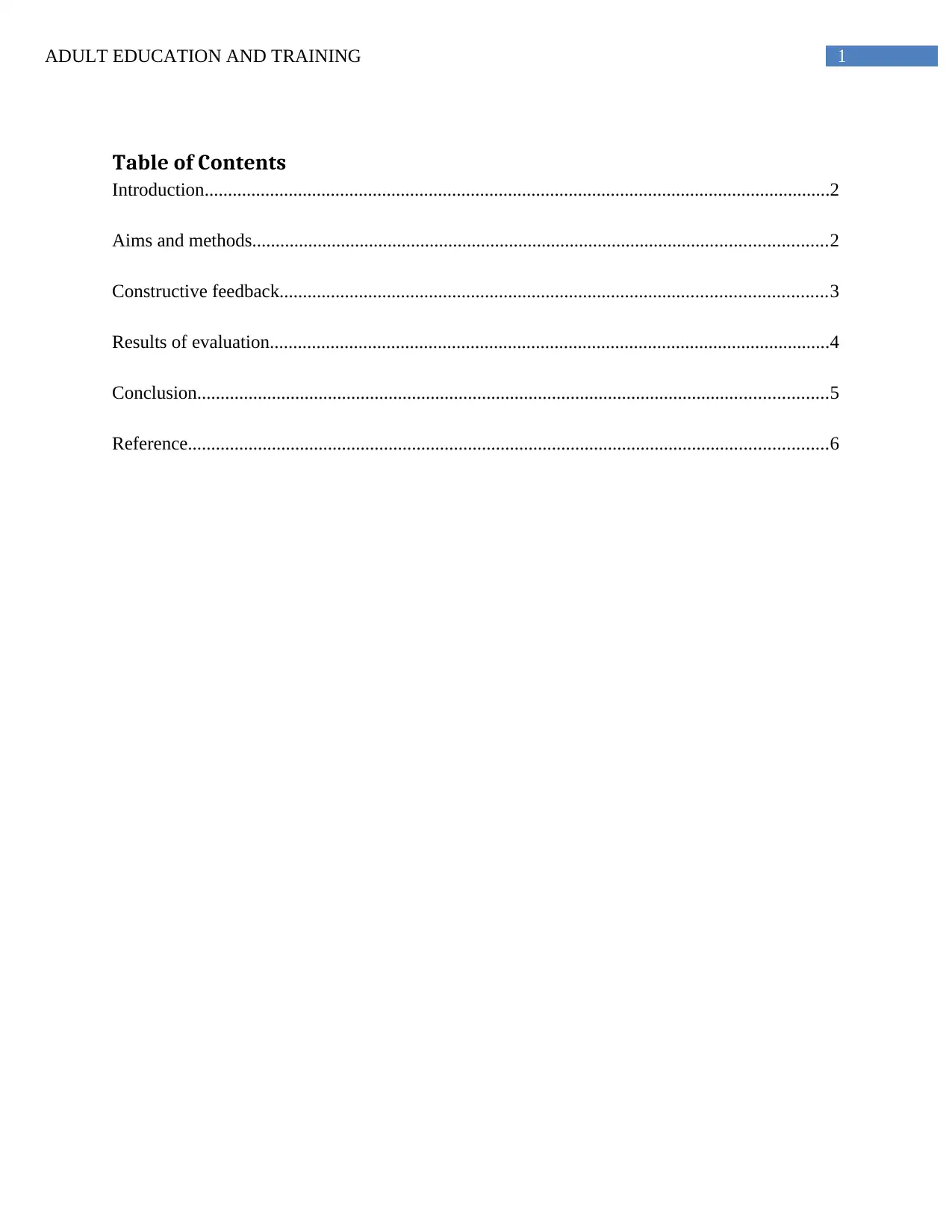
1ADULT EDUCATION AND TRAINING
Table of Contents
Introduction......................................................................................................................................2
Aims and methods...........................................................................................................................2
Constructive feedback.....................................................................................................................3
Results of evaluation........................................................................................................................4
Conclusion.......................................................................................................................................5
Reference.........................................................................................................................................6
Table of Contents
Introduction......................................................................................................................................2
Aims and methods...........................................................................................................................2
Constructive feedback.....................................................................................................................3
Results of evaluation........................................................................................................................4
Conclusion.......................................................................................................................................5
Reference.........................................................................................................................................6
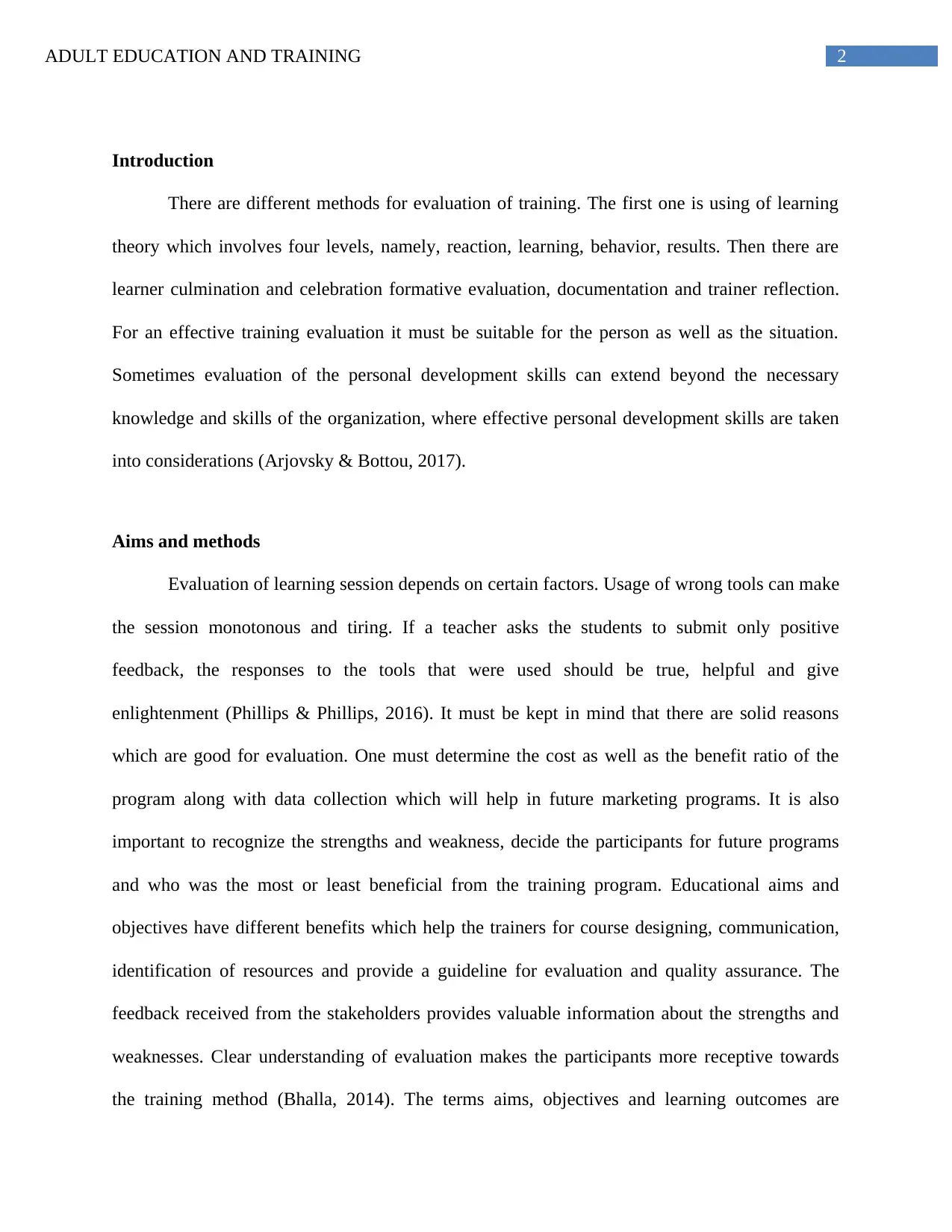
2ADULT EDUCATION AND TRAINING
Introduction
There are different methods for evaluation of training. The first one is using of learning
theory which involves four levels, namely, reaction, learning, behavior, results. Then there are
learner culmination and celebration formative evaluation, documentation and trainer reflection.
For an effective training evaluation it must be suitable for the person as well as the situation.
Sometimes evaluation of the personal development skills can extend beyond the necessary
knowledge and skills of the organization, where effective personal development skills are taken
into considerations (Arjovsky & Bottou, 2017).
Aims and methods
Evaluation of learning session depends on certain factors. Usage of wrong tools can make
the session monotonous and tiring. If a teacher asks the students to submit only positive
feedback, the responses to the tools that were used should be true, helpful and give
enlightenment (Phillips & Phillips, 2016). It must be kept in mind that there are solid reasons
which are good for evaluation. One must determine the cost as well as the benefit ratio of the
program along with data collection which will help in future marketing programs. It is also
important to recognize the strengths and weakness, decide the participants for future programs
and who was the most or least beneficial from the training program. Educational aims and
objectives have different benefits which help the trainers for course designing, communication,
identification of resources and provide a guideline for evaluation and quality assurance. The
feedback received from the stakeholders provides valuable information about the strengths and
weaknesses. Clear understanding of evaluation makes the participants more receptive towards
the training method (Bhalla, 2014). The terms aims, objectives and learning outcomes are
Introduction
There are different methods for evaluation of training. The first one is using of learning
theory which involves four levels, namely, reaction, learning, behavior, results. Then there are
learner culmination and celebration formative evaluation, documentation and trainer reflection.
For an effective training evaluation it must be suitable for the person as well as the situation.
Sometimes evaluation of the personal development skills can extend beyond the necessary
knowledge and skills of the organization, where effective personal development skills are taken
into considerations (Arjovsky & Bottou, 2017).
Aims and methods
Evaluation of learning session depends on certain factors. Usage of wrong tools can make
the session monotonous and tiring. If a teacher asks the students to submit only positive
feedback, the responses to the tools that were used should be true, helpful and give
enlightenment (Phillips & Phillips, 2016). It must be kept in mind that there are solid reasons
which are good for evaluation. One must determine the cost as well as the benefit ratio of the
program along with data collection which will help in future marketing programs. It is also
important to recognize the strengths and weakness, decide the participants for future programs
and who was the most or least beneficial from the training program. Educational aims and
objectives have different benefits which help the trainers for course designing, communication,
identification of resources and provide a guideline for evaluation and quality assurance. The
feedback received from the stakeholders provides valuable information about the strengths and
weaknesses. Clear understanding of evaluation makes the participants more receptive towards
the training method (Bhalla, 2014). The terms aims, objectives and learning outcomes are
⊘ This is a preview!⊘
Do you want full access?
Subscribe today to unlock all pages.

Trusted by 1+ million students worldwide
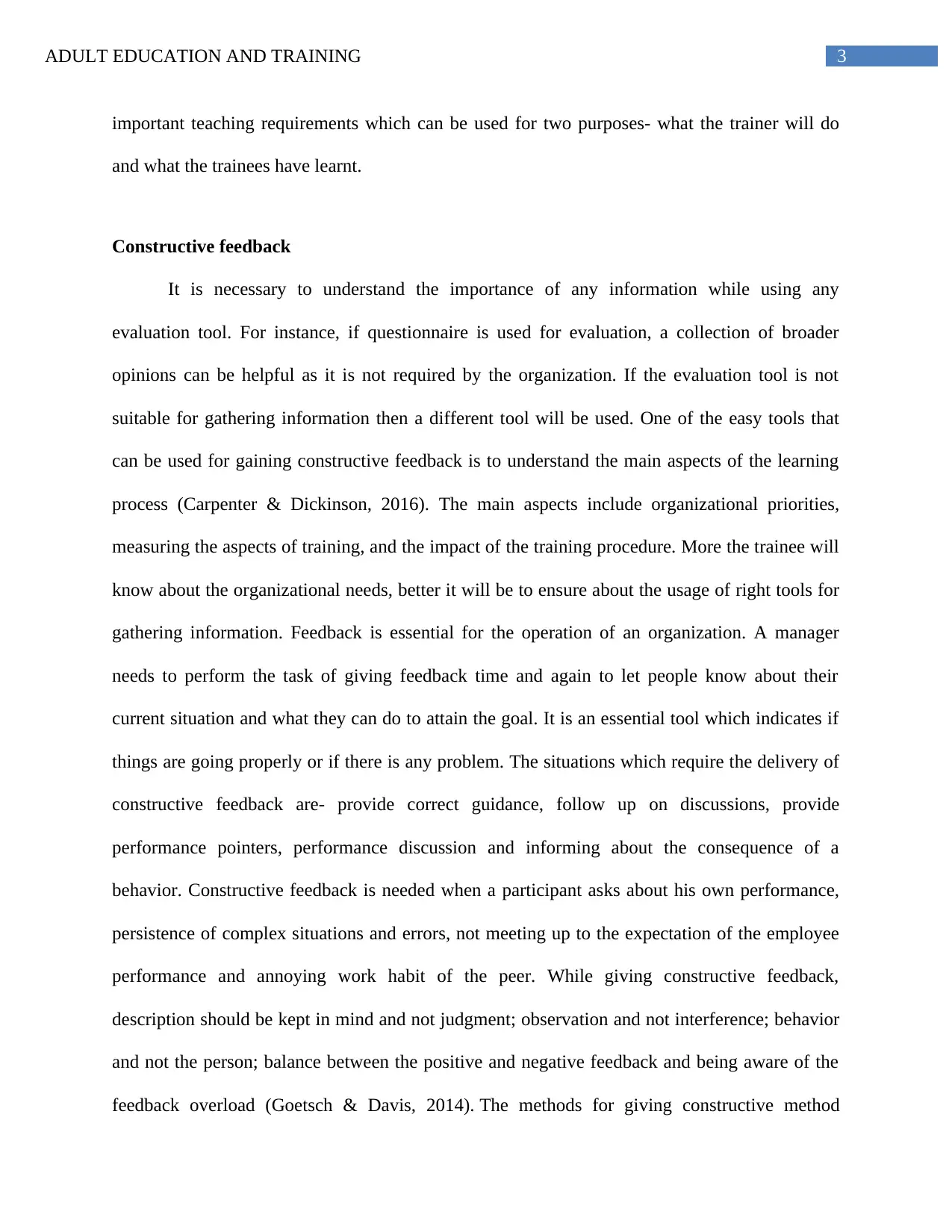
3ADULT EDUCATION AND TRAINING
important teaching requirements which can be used for two purposes- what the trainer will do
and what the trainees have learnt.
Constructive feedback
It is necessary to understand the importance of any information while using any
evaluation tool. For instance, if questionnaire is used for evaluation, a collection of broader
opinions can be helpful as it is not required by the organization. If the evaluation tool is not
suitable for gathering information then a different tool will be used. One of the easy tools that
can be used for gaining constructive feedback is to understand the main aspects of the learning
process (Carpenter & Dickinson, 2016). The main aspects include organizational priorities,
measuring the aspects of training, and the impact of the training procedure. More the trainee will
know about the organizational needs, better it will be to ensure about the usage of right tools for
gathering information. Feedback is essential for the operation of an organization. A manager
needs to perform the task of giving feedback time and again to let people know about their
current situation and what they can do to attain the goal. It is an essential tool which indicates if
things are going properly or if there is any problem. The situations which require the delivery of
constructive feedback are- provide correct guidance, follow up on discussions, provide
performance pointers, performance discussion and informing about the consequence of a
behavior. Constructive feedback is needed when a participant asks about his own performance,
persistence of complex situations and errors, not meeting up to the expectation of the employee
performance and annoying work habit of the peer. While giving constructive feedback,
description should be kept in mind and not judgment; observation and not interference; behavior
and not the person; balance between the positive and negative feedback and being aware of the
feedback overload (Goetsch & Davis, 2014). The methods for giving constructive method
important teaching requirements which can be used for two purposes- what the trainer will do
and what the trainees have learnt.
Constructive feedback
It is necessary to understand the importance of any information while using any
evaluation tool. For instance, if questionnaire is used for evaluation, a collection of broader
opinions can be helpful as it is not required by the organization. If the evaluation tool is not
suitable for gathering information then a different tool will be used. One of the easy tools that
can be used for gaining constructive feedback is to understand the main aspects of the learning
process (Carpenter & Dickinson, 2016). The main aspects include organizational priorities,
measuring the aspects of training, and the impact of the training procedure. More the trainee will
know about the organizational needs, better it will be to ensure about the usage of right tools for
gathering information. Feedback is essential for the operation of an organization. A manager
needs to perform the task of giving feedback time and again to let people know about their
current situation and what they can do to attain the goal. It is an essential tool which indicates if
things are going properly or if there is any problem. The situations which require the delivery of
constructive feedback are- provide correct guidance, follow up on discussions, provide
performance pointers, performance discussion and informing about the consequence of a
behavior. Constructive feedback is needed when a participant asks about his own performance,
persistence of complex situations and errors, not meeting up to the expectation of the employee
performance and annoying work habit of the peer. While giving constructive feedback,
description should be kept in mind and not judgment; observation and not interference; behavior
and not the person; balance between the positive and negative feedback and being aware of the
feedback overload (Goetsch & Davis, 2014). The methods for giving constructive method
Paraphrase This Document
Need a fresh take? Get an instant paraphrase of this document with our AI Paraphraser
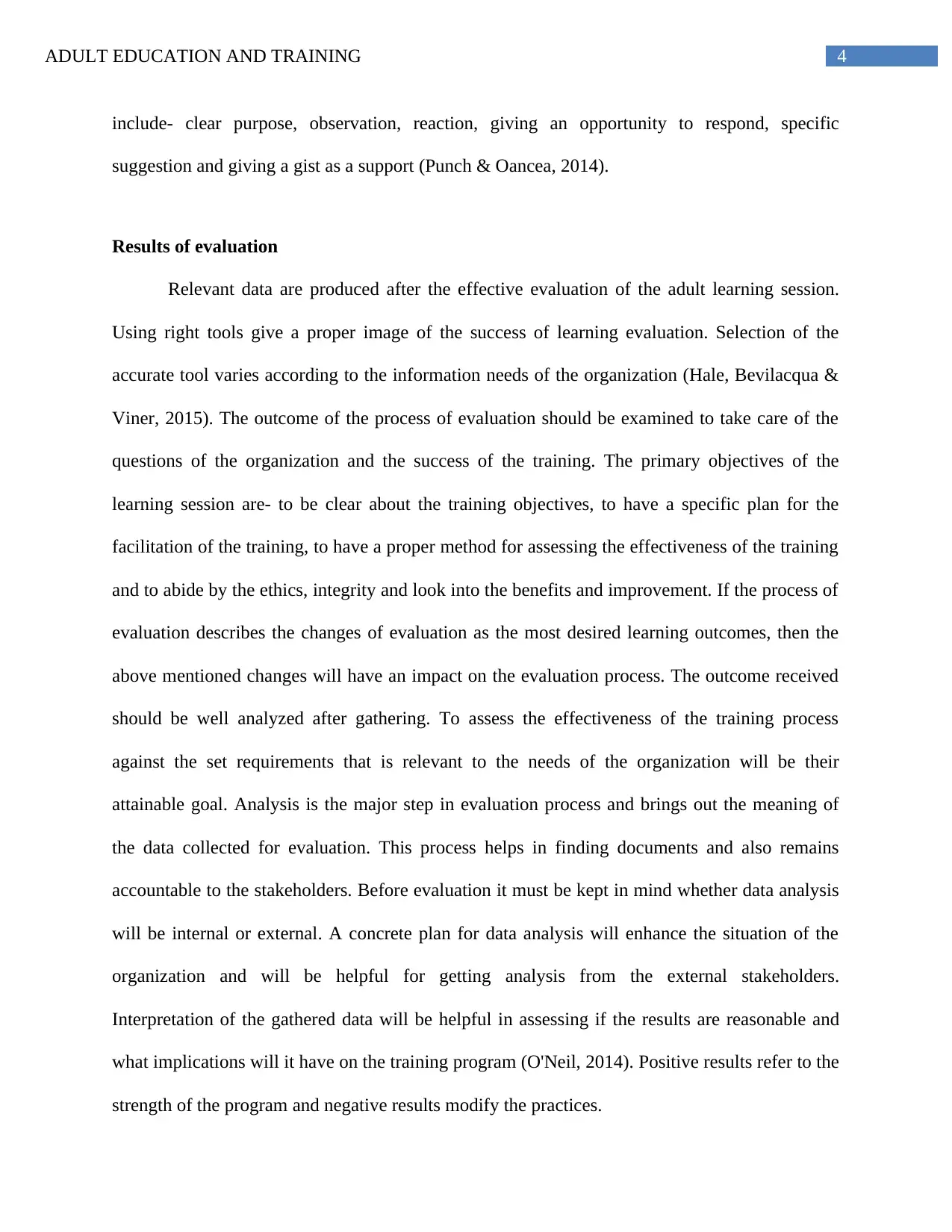
4ADULT EDUCATION AND TRAINING
include- clear purpose, observation, reaction, giving an opportunity to respond, specific
suggestion and giving a gist as a support (Punch & Oancea, 2014).
Results of evaluation
Relevant data are produced after the effective evaluation of the adult learning session.
Using right tools give a proper image of the success of learning evaluation. Selection of the
accurate tool varies according to the information needs of the organization (Hale, Bevilacqua &
Viner, 2015). The outcome of the process of evaluation should be examined to take care of the
questions of the organization and the success of the training. The primary objectives of the
learning session are- to be clear about the training objectives, to have a specific plan for the
facilitation of the training, to have a proper method for assessing the effectiveness of the training
and to abide by the ethics, integrity and look into the benefits and improvement. If the process of
evaluation describes the changes of evaluation as the most desired learning outcomes, then the
above mentioned changes will have an impact on the evaluation process. The outcome received
should be well analyzed after gathering. To assess the effectiveness of the training process
against the set requirements that is relevant to the needs of the organization will be their
attainable goal. Analysis is the major step in evaluation process and brings out the meaning of
the data collected for evaluation. This process helps in finding documents and also remains
accountable to the stakeholders. Before evaluation it must be kept in mind whether data analysis
will be internal or external. A concrete plan for data analysis will enhance the situation of the
organization and will be helpful for getting analysis from the external stakeholders.
Interpretation of the gathered data will be helpful in assessing if the results are reasonable and
what implications will it have on the training program (O'Neil, 2014). Positive results refer to the
strength of the program and negative results modify the practices.
include- clear purpose, observation, reaction, giving an opportunity to respond, specific
suggestion and giving a gist as a support (Punch & Oancea, 2014).
Results of evaluation
Relevant data are produced after the effective evaluation of the adult learning session.
Using right tools give a proper image of the success of learning evaluation. Selection of the
accurate tool varies according to the information needs of the organization (Hale, Bevilacqua &
Viner, 2015). The outcome of the process of evaluation should be examined to take care of the
questions of the organization and the success of the training. The primary objectives of the
learning session are- to be clear about the training objectives, to have a specific plan for the
facilitation of the training, to have a proper method for assessing the effectiveness of the training
and to abide by the ethics, integrity and look into the benefits and improvement. If the process of
evaluation describes the changes of evaluation as the most desired learning outcomes, then the
above mentioned changes will have an impact on the evaluation process. The outcome received
should be well analyzed after gathering. To assess the effectiveness of the training process
against the set requirements that is relevant to the needs of the organization will be their
attainable goal. Analysis is the major step in evaluation process and brings out the meaning of
the data collected for evaluation. This process helps in finding documents and also remains
accountable to the stakeholders. Before evaluation it must be kept in mind whether data analysis
will be internal or external. A concrete plan for data analysis will enhance the situation of the
organization and will be helpful for getting analysis from the external stakeholders.
Interpretation of the gathered data will be helpful in assessing if the results are reasonable and
what implications will it have on the training program (O'Neil, 2014). Positive results refer to the
strength of the program and negative results modify the practices.
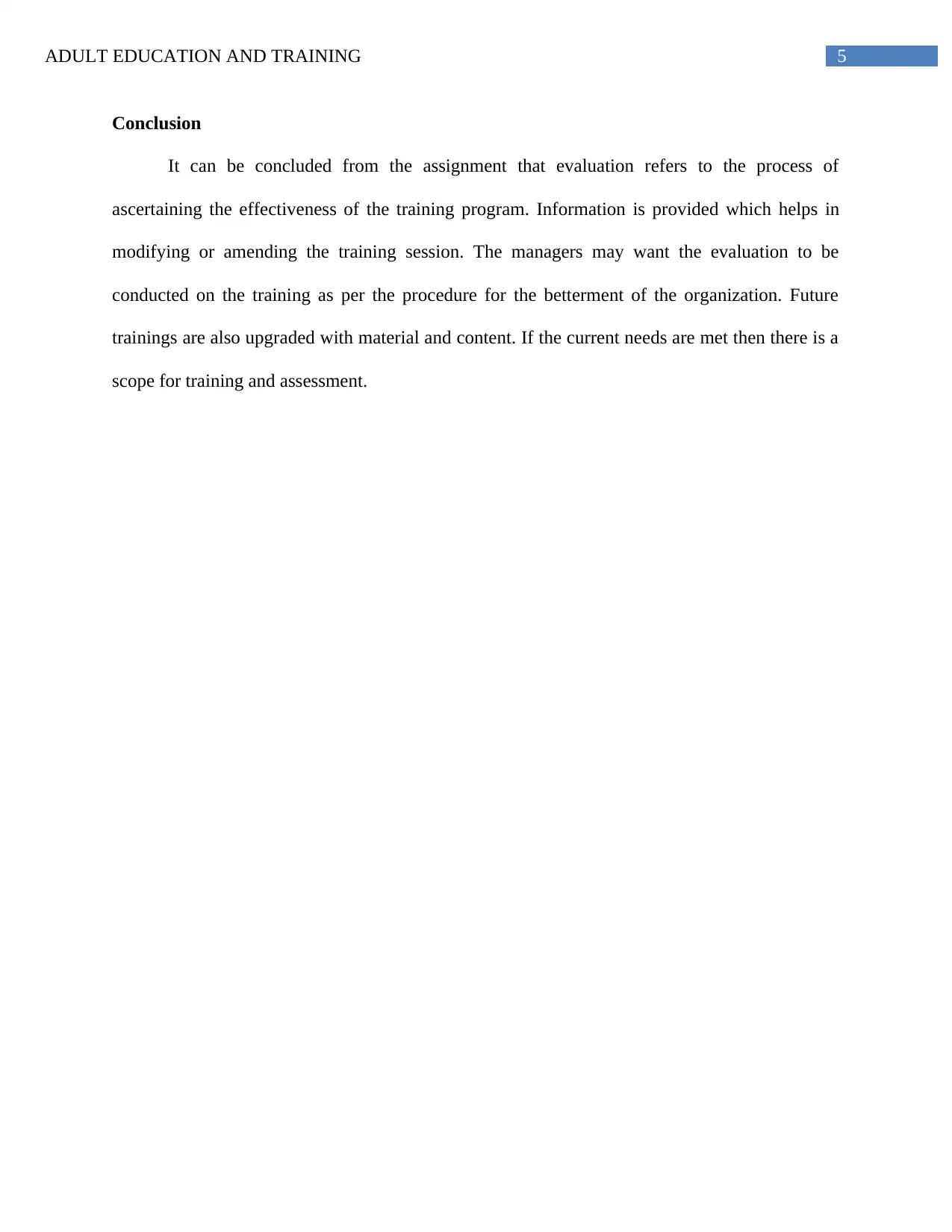
5ADULT EDUCATION AND TRAINING
Conclusion
It can be concluded from the assignment that evaluation refers to the process of
ascertaining the effectiveness of the training program. Information is provided which helps in
modifying or amending the training session. The managers may want the evaluation to be
conducted on the training as per the procedure for the betterment of the organization. Future
trainings are also upgraded with material and content. If the current needs are met then there is a
scope for training and assessment.
Conclusion
It can be concluded from the assignment that evaluation refers to the process of
ascertaining the effectiveness of the training program. Information is provided which helps in
modifying or amending the training session. The managers may want the evaluation to be
conducted on the training as per the procedure for the betterment of the organization. Future
trainings are also upgraded with material and content. If the current needs are met then there is a
scope for training and assessment.
⊘ This is a preview!⊘
Do you want full access?
Subscribe today to unlock all pages.

Trusted by 1+ million students worldwide
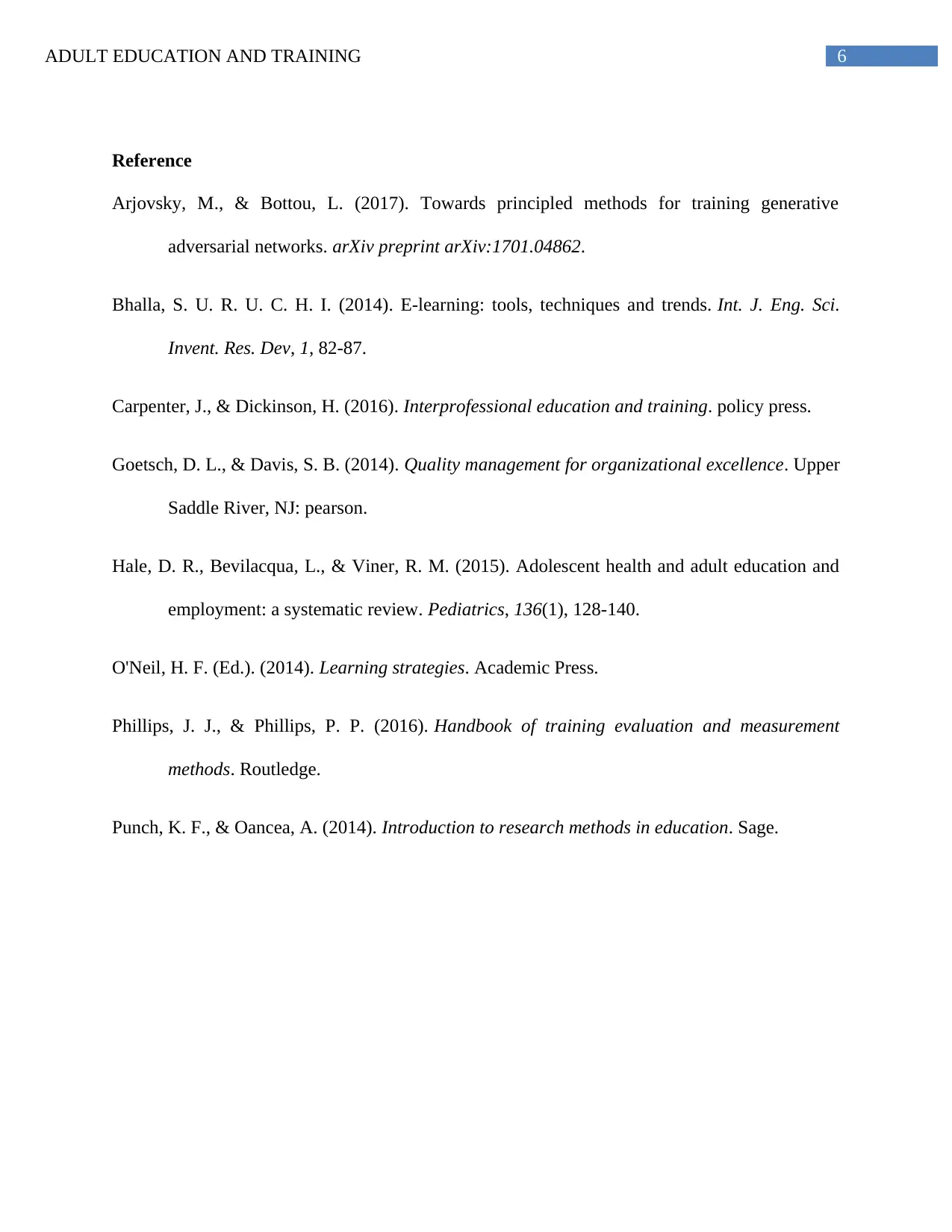
6ADULT EDUCATION AND TRAINING
Reference
Arjovsky, M., & Bottou, L. (2017). Towards principled methods for training generative
adversarial networks. arXiv preprint arXiv:1701.04862.
Bhalla, S. U. R. U. C. H. I. (2014). E-learning: tools, techniques and trends. Int. J. Eng. Sci.
Invent. Res. Dev, 1, 82-87.
Carpenter, J., & Dickinson, H. (2016). Interprofessional education and training. policy press.
Goetsch, D. L., & Davis, S. B. (2014). Quality management for organizational excellence. Upper
Saddle River, NJ: pearson.
Hale, D. R., Bevilacqua, L., & Viner, R. M. (2015). Adolescent health and adult education and
employment: a systematic review. Pediatrics, 136(1), 128-140.
O'Neil, H. F. (Ed.). (2014). Learning strategies. Academic Press.
Phillips, J. J., & Phillips, P. P. (2016). Handbook of training evaluation and measurement
methods. Routledge.
Punch, K. F., & Oancea, A. (2014). Introduction to research methods in education. Sage.
Reference
Arjovsky, M., & Bottou, L. (2017). Towards principled methods for training generative
adversarial networks. arXiv preprint arXiv:1701.04862.
Bhalla, S. U. R. U. C. H. I. (2014). E-learning: tools, techniques and trends. Int. J. Eng. Sci.
Invent. Res. Dev, 1, 82-87.
Carpenter, J., & Dickinson, H. (2016). Interprofessional education and training. policy press.
Goetsch, D. L., & Davis, S. B. (2014). Quality management for organizational excellence. Upper
Saddle River, NJ: pearson.
Hale, D. R., Bevilacqua, L., & Viner, R. M. (2015). Adolescent health and adult education and
employment: a systematic review. Pediatrics, 136(1), 128-140.
O'Neil, H. F. (Ed.). (2014). Learning strategies. Academic Press.
Phillips, J. J., & Phillips, P. P. (2016). Handbook of training evaluation and measurement
methods. Routledge.
Punch, K. F., & Oancea, A. (2014). Introduction to research methods in education. Sage.
1 out of 7
Related Documents
Your All-in-One AI-Powered Toolkit for Academic Success.
+13062052269
info@desklib.com
Available 24*7 on WhatsApp / Email
![[object Object]](/_next/static/media/star-bottom.7253800d.svg)
Unlock your academic potential
Copyright © 2020–2025 A2Z Services. All Rights Reserved. Developed and managed by ZUCOL.





